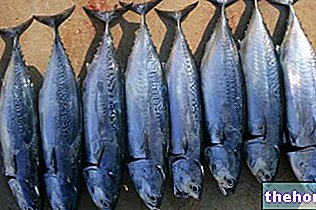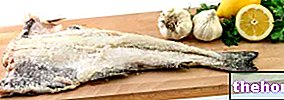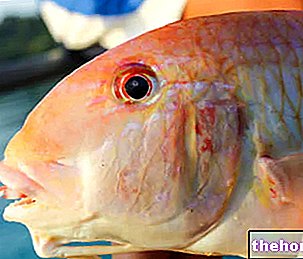Degradation of Fish
From the moment of capture to its food use, fresh fish must necessarily be refrigerated; conservation of the fish in ice at 0 ° C (constant temperature) does not alter its composition for about 4 - 7 days.

Over time the irreversible reaction comes to the formation of monoethylamine And formaldehyde (responsible for the typical smell of spoiled fish) release of sulfide acid (which contributes to the formation of a nauseating aroma) and biogenic amines (histamine, tryptamine, cadaverine, putrescine, tyramine).
NB. Histamine is already present in moderate quantities in fresh fish and the increase in its concentration can cause pseudo-allergic reactions in hypersensitive subjects (appearance of red dots on the skin, nausea, abdominal pain, etc.), similarly to the ingestion of strawberries when there is a subjective predisposition.
In addition to chemical transformations, fish can be affected by microbiological contamination especially of bacteria: Pseudomonas, Moraxella And Flavobacterium-Cytophage.
How is it preserved?
Preserving fish properly is a very important aspect both from a hygienic, gustatory and economic point of view (reduction of waste due to bad storage).
Fish and all fishery products (molluscs and crustaceans) are highly perishable due to the high intake of polyunsaturated fatty acids (PUFA), the high concentration of free amino acids and nitrogenous groups, and the high concentration of PROPER proteolytic enzymes. . Furthermore, the possible microbial load (bivalve molluscs and bottom or valley flatfish), viral (bivalve molluscs) and parasites (all fish), in the absence of adequate conservation, increases exponentially, also increasing the risk of parasitosis, intoxication, infection or food poisoning.
Fish can be preserved in many ways, some of which are ancient or traditional and others innovative or technological.
Refrigeration
On fishing boats, the fish caught is immediately subjected to a first so-called treatment icing, that is, covering the product with crushed ice; alternatively it comes gutted, washed with sea water and stored at -2 ° C to freeze the superficial parts. On-board refrigeration allows the fish to be kept fresh for a total of 14 days (from collection to table).
Home or restaurant refrigeration is based on a few simple steps: removal from the container, washing, eventual evisceration, re-washing, arrangement in polyethylene basins with perforated grids for draining and covering in ice. and storage at 0 ° C. Home storage potential: 2-3 days.
Freezing
It is a preservation method that lowers the food temperature to -20 ° C or -30 ° C. Freezing or slow freezing makes sure that the water molecules aggregate forming ice macrocrystals; it is mainly used for large fish and is carried out through the use of cold rooms that reach -50 ° C or -60 ° C or by means of of freezing tunnels that exploit liquid nitrogen at -60 ° C.
Home storage of frozen fish takes place in chest or cabinet freezers.
Freezing
It is a preservation method that lowers the temperature so quickly that it does not allow the formation of ice macrocrystals; in their place very small crystals are formed. the relative leakage of organic liquids. This conservation is obtained using forced air at -40 ° C and the product must reach -18 ° C within 4 hours; it can only be carried out in centers authorized by the USSL.
Frozen fish must be kept at a transport temperature not <-18 ° C and without interrupting the cold chain.
Boxing
It is a conservation technique especially useful for small fish such as sardines and anchovies, but also for mackerel, salmon, tuna and some shellfish such as mussels and clams.
The fish to be canned must be fresh, clean, washed in brine, cut, placed in boxes, covered with preservative substance and kept at + 70 ° C; subsequently, the boxes are sealed with a lid, quickly sterilized at 120 ° C and cooled just as quickly.
The home or restaurant preservation must take place according to the indications mentioned on the label.
Smoking
It is a fish preservation technique typical of Northern Europe which has very ancient origins; it is based on the exposure of pieces of fish, or small whole fish, to the smoke obtained from the combustion of wood.
The fish must first be cleaned, washed and placed (minutes or hours) in chambers saturated with smoke obtained from wood Birch, However, chestnut or Oak, which aromatizes and dehydrates the food, further favoring its conservation by penetration of the aromatic substances (increase in polycyclic aromatic hydrocarbons).
Smoking is mainly used for the preservation of trout, salmon, herring and eel, thus generally consumed as appetizers.
Dry salting
Dry salting is also a very ancient preservation method that exploits the osmotic power of coarse salt on the meat. It is mainly applied for the species: cod, herring and anchovy. Dry salting can be started directly on the fishing boat or later, after landing, but in any case after evisceration, washing and filleting.
To reduce the humidity of the food to no more than 40%, dry salting requires numerous checks and various processes useful for removing the liquids leaking from the fish tissue and replacing the covering salt.
Wet salting
It is a quick preservation method; it consists in arranging the fish in ceramic containers, inside which they are covered with a 15-30% aqueous solution of sodium chloride; the wet salting must be kept for a few days and ends with the drying of the fish which reaches an overall humidity of 40%.
Drying
Like smoking, drying is also an ancient technique of preserving fish (cod) used mainly in the Nordic countries; traditionally, the fish should be cleaned, gutted, washed, boned, dried and left hanging on special trellises in the sun for several months, until a woody consistency (typical of stockfish) is reached. On an industrial level, cod is exposed for 2-3 months to hot air currents which lead to a reduction of moisture in the meat by up to 14%.
Before consumption, dried fish should be made more "elastic" through the typing with a wooden hammer or by passing it under suitable crushing rollers; subsequently, it is necessary to rehydrate it after soaking it for 2-3 days in running water.
Bibliography:
- Advanced laboratory course of cooking services - Cometto, Columbo - Markes - pag. 77:83























-nelle-carni-di-maiale.jpg)




